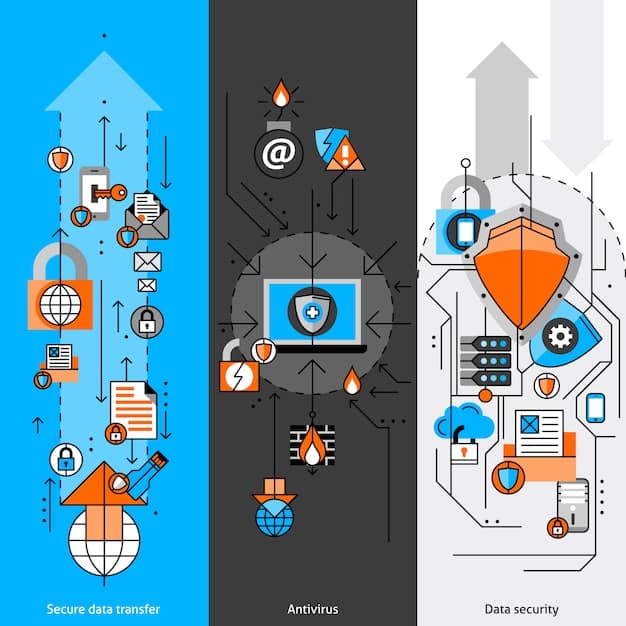Cybersecurity Threats: Government Initiatives to Protect Your Business

Cybersecurity threats are prompting new government initiatives in the U.S. aimed at protecting businesses, involving updated regulations, increased funding, and enhanced information-sharing programs to combat evolving cyber risks.
The digital landscape is increasingly fraught with cybersecurity threats, posing significant risks to businesses of all sizes. In response, the U.S. government is rolling out new initiatives designed to bolster cyber defenses and protect businesses from these evolving attacks.
Understanding the Rising Tide of Cybersecurity Threats
The digital age has brought unprecedented opportunities for businesses, alongside a parallel surge in cybersecurity threats. Understanding the nature of these threats and their potential impact is crucial for effective protection.
Cyberattacks are becoming more sophisticated and frequent, targeting sensitive data, critical infrastructure, and financial resources. From ransomware attacks to phishing scams, businesses face a constant barrage of threats that can disrupt operations, damage reputations, and incur significant financial losses.
Common Types of Cybersecurity Threats
Several types of cyber threats pose a significant danger to the businesses in the U.S. Here are a few common types:
- Ransomware Attacks: Cybercriminals encrypt critical data and demand a ransom for its release, crippling business operations until the ransom is paid.
- Phishing Scams: Deceptive emails or messages trick employees into divulging sensitive information or clicking malicious links, leading to data breaches and malware infections.
- Malware Infections: Viruses, worms, and trojans infiltrate systems, causing damage, stealing data, and disrupting network operations.
- Distributed Denial-of-Service (DDoS) Attacks: Overwhelming a network with traffic to disrupt online services and render websites inaccessible.
These threats are constantly evolving, requiring businesses to stay vigilant and proactive in their cybersecurity efforts. The consequences of falling victim to a cyberattack can be devastating, underscoring the importance of implementing robust security measures and staying informed about the latest threats.
In response to this escalating threat landscape, the government is stepping up its efforts to support businesses and enhance national cybersecurity. These initiatives aim to create a more secure digital environment, empowering businesses to thrive without constantly fearing cyberattacks.
Overview of New Government Cybersecurity Initiatives
Recognizing the urgency of the situation, the U.S. government has launched several new initiatives to combat cybersecurity threats and protect businesses from attacks. These initiatives span various agencies and departments, each contributing to a comprehensive approach to cybersecurity defense.
These initiatives are designed to provide resources, guidance, and support to businesses of all sizes, helping them to strengthen their cybersecurity posture and mitigate potential risks. By fostering collaboration and information sharing, the government aims to build a resilient cybersecurity ecosystem that can effectively deter and respond to attacks.
Key Government Agencies Involved
Several government agencies are playing crucial roles in the new cybersecurity initiatives.
- Cybersecurity and Infrastructure Security Agency (CISA): Leads national efforts to protect critical infrastructure from cyber and physical threats.
- National Institute of Standards and Technology (NIST): Develops cybersecurity standards and best practices to help organizations manage their risks.
- Federal Bureau of Investigation (FBI): Investigates cybercrimes and works to bring perpetrators to justice.
- Small Business Administration (SBA): Provides resources and guidance to help small businesses improve their cybersecurity.
These agencies collaborate to develop and implement cybersecurity programs that address the evolving threat landscape. By leveraging their expertise and resources, they are working to create a more secure digital environment for businesses across the country.

The success of these initiatives depends on active participation from both the government and the private sector. By working together, they can create a strong defense against cyber threats and protect the nation’s economic interests.
Increased Funding and Resource Allocation
One of the most significant aspects of the new government cybersecurity initiatives is the increased funding and resource allocation dedicated to cybersecurity efforts. This infusion of resources is essential for supporting research, developing new technologies, and providing assistance to businesses in need.
The government is investing in cybersecurity programs to equip businesses with the tools and knowledge they need to protect themselves from cyberattacks. These funds are being used to support several critical areas, including threat intelligence, incident response, and workforce development.
Specific Areas of Funding
The allocated cybersecurity funds are supporting a variety of areas:
- Grants for Cybersecurity Training: Providing funding to organizations that offer cybersecurity training and certification programs for businesses and individuals.
- Cybersecurity Research and Development: Investing in research that explores new cybersecurity technologies and mitigates emerging threats.
- Enhancement of Cyber Threat Intelligence Sharing: Improving the exchange of information about cyber threats between government agencies and the public sector.
- Support for Small Businesses: Offering financial assistance and resources to help small businesses implement cybersecurity measures and recover from cyberattacks.
By channeling resources into these areas, the government is helping business to improve their cybersecurity posture and stay ahead of the evolving threat landscape. The increased funding reflects a commitment to prioritizing cybersecurity and protecting the nation’s economic interests.
This increased funding also helps to reduce the financial burden on businesses. By providing grants and financial assistance, the government enables organizations to invest in essential security measures without jeopardizing their financial stability.
Enhanced Information Sharing and Collaboration
Effective cybersecurity requires collaboration and information-sharing between businesses, government agencies, and cybersecurity providers. The new government initiatives emphasize the importance of creating secure networks for sharing threat intelligence and best practices.
By sharing information about emerging threats and successful defense strategies, organizations can collectively enhance their cybersecurity posture and reduce the risk of cyberattacks. The government is facilitating this collaboration by establishing platforms and programs that encourage dialogue and knowledge exchange.
Benefits of Enhanced Information Sharing
Information sharing has significant benefits:
- Early Detection of Threats: Sharing information about emerging threats enables organizations to detect and respond to attacks more quickly.
- Improved Incident Response: Collaboration helps organizations to develop more effective incident response plans and minimize the impact of cyberattacks.
- Enhanced Cybersecurity Posture: By learning from the experiences of others, businesses can identify vulnerabilities and improve their overall security.
- Better Resource Allocation: Sharing resources and expertise strengthens the collective defense against cyber threats and maximizes the impact of security investments.
The government is also working to establish clear guidelines for information sharing, ensuring that sensitive data is protected and privacy concerns are addressed. By creating a trusted environment for collaboration, the initiatives aim to encourage broad participation and foster a more secure digital ecosystem.

Effective information sharing is a proactive step in combating cyberthreats. It prepares companies for cyberattacks and enables them to respond to such attacks rapidly.
Strengthening Cybersecurity Standards and Regulations
To ensure that businesses are adequately protected from cyber threats, the U.S. government is strengthening cybersecurity standards and regulations. These standards provide guidelines for implementing security measures and managing risks, helping organizations to establish a solid foundation for their cybersecurity programs.
The National Institute of Standards and Technology (NIST) is playing a key role in developing and updating cybersecurity standards. NIST’s Cybersecurity Framework provides a comprehensive set of best practices for managing cyber risks, and it is widely adopted by organizations across various industries.
Key Cybersecurity Standards and Regulations
The most prominent standards and regulations are:
- NIST Cybersecurity Framework: A comprehensive guide for managing cybersecurity risks, providing organizations with a structured approach to identify, protect, detect, respond to, and recover from cyberattacks.
- Health Insurance Portability and Accountability Act (HIPAA): For the healthcare industry, this mandates the protection of sensitive patient information.
- Gramm-Leach-Bliley Act (GLBA): Requires financial institutions to protect customer information and implement security measures to prevent fraud.
- California Consumer Privacy Act (CCPA): Grants California consumers the right to know what personal information is collected about them and to request that it be deleted.
The government is also working to harmonize cybersecurity standards across different sectors, reducing compliance burdens and promoting consistency in security practices. By establishing clear expectations and guidelines, these standards empower businesses to take proactive steps to protect their data and systems.
The government is also providing resources and support to help businesses comply with cybersecurity standards and regulations. This assistance includes training programs, cybersecurity assessments, and access to expert guidance.
Preparing for Future Cybersecurity Challenges
The landscape is ever-evolving, and businesses must stay vigilant to adapt accordingly and proactively prepare for challenges. The government cybersecurity initiatives aim to equip businesses with the knowledge, resources, and partnerships they need to address future cyber threats.
As technology advances and cybercriminals develop new tactics, businesses must continuously update their security measures and stay informed about the latest threats. The government is supporting this preparedness by investing in cybersecurity research, promoting information sharing, and enhancing cybersecurity training and education.
Strategies for Businesses to Stay Ahead
Here are some strategies for businesses to stay ahead of cybersecurity challenges:
- Continuous Monitoring and Assessment: Regularly assess your cybersecurity posture and monitor for vulnerabilities to identify and address potential weaknesses.
- Employee Training: Provide regular training to employees on cybersecurity best practices, equipping them to recognize and prevent cyberattacks.
- Incident Response Planning: Develop and regularly update your incident response plan, outlining the steps to take in the event of a cyberattack.
- Collaboration and Information Sharing: Participate in information sharing initiatives and collaborate with other organizations to stay informed about emerging threats and best practices.
The government is also focusing on building a strong cybersecurity workforce by supporting education and training programs. By investing in the development of skilled cybersecurity professionals, the government is helping to ensure that businesses have access to expertise they need to protect themselves from cyber threats.
Through proactive planning and investment, businesses can strengthen their resilience and mitigate the impact of future cyberattacks.
| Key Point | Brief Description |
|---|---|
| 🛡️ Government Initiatives | New programs offer resources and support to protect businesses from cyber threats. |
| 💰 Increased Funding | More funds are allocated to cybersecurity research, training, and threat intelligence. |
| 🤝 Information Sharing | Collaboration improves threat detection and helps businesses stay ahead of cyber challenges. |
| 📜 Strengthened Standards | Enhanced regulations provide a framework for businesses to protect data and systems. |
FAQ: Cybersecurity Threats and Government Initiatives
▼
The main goals include protecting businesses from cyber threats, bolstering defenses with funding, and promoting information sharing between involved departments.
▼
Small businesses can access funding through grants, resources from the SBA, and cybersecurity training programs offered by various initiatives.
▼
CISA leads national efforts in protecting critical infrastructure, shares threat advisories, and offers tools to enhance cyber resilience for businesses and organizations.
▼
Improve your plan by regularly updating it, conducting simulations, and incorporating insights from information-sharing platforms and cybersecurity exercises.
▼
Avoid using weak passwords, neglecting employee training, failing to update software, and not having incident plans. It is important to stay vigilant on possible threats.
Conclusion
As businesses face an increasingly complex landscape of cybersecurity threats, the new government initiatives offer a valuable framework for enhancing protection and resilience. By leveraging increased funding, improved information sharing, and strengthened standards, businesses can effectively mitigate cyber risks and safeguard their operations in the digital age.





